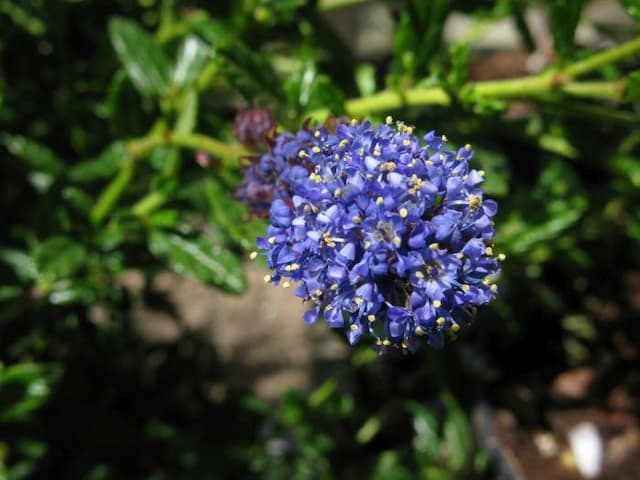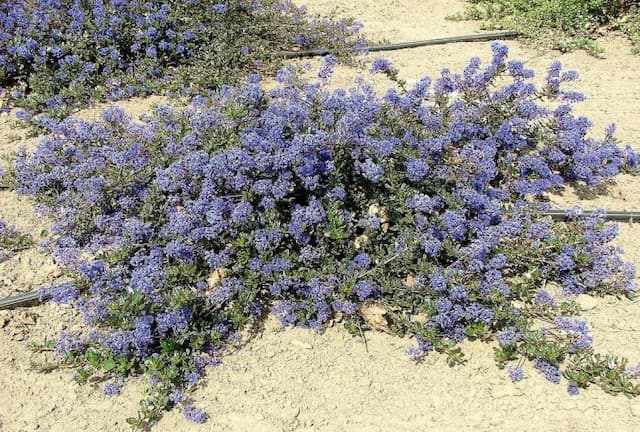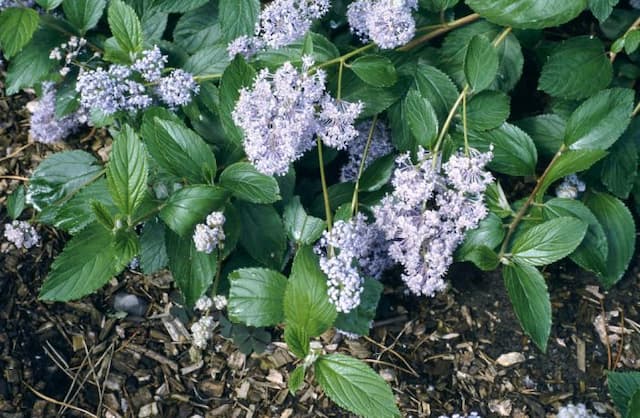New Jersey Tea Ceanothus × pallidus 'Perle Rose'

ABOUT
The plant Ceanothus × pallidus 'Perle Rose', commonly known as the New Jersey Tea, is a decorative shrub that boasts a dense mound of glossy, green foliage. Each leaf is small and oval-shaped, with a somewhat wrinkled texture and a margin that may be subtly toothed or wavy. Come the flowering season, the New Jersey Tea erupts with clusters of delicate blossoms. The flowers are a soft, pink color, sometimes described as a pale rose shade. These blooms form rounded or cone-shaped clusters that cover the shrub, giving it a frothy, opulent look that is particularly attractive to bees, butterflies, and other pollinators. Despite not detailing the plant's dimensions, we can say that it presents itself with a robust and lush appearance, making it a favorite among gardeners who seek to add a touch of soft color and inviting texture to their landscapes.
About this plant
 Names
NamesFamily
Rhamnaceae.
Synonyms
New Jersey Tea, Red Root, Wild Snowball.
Common names
Ceanothus × pallidus 'Perle Rose'.
 Toxicity
ToxicityTo humans
The New Jersey Tea (Ceanothus × pallidus 'Perle Rose') is not widely recognized as toxic to humans. There is limited information about its toxicity; hence, it's always prudent to avoid ingesting parts of ornamental plants unless they are known to be edible. As with any plant, those with plant allergies or sensitive individuals might experience adverse reactions from handling or accidental ingestion, but generally, there are no well-documented cases of poisoning from this plant in humans. Should any symptoms arise from interaction with New Jersey Tea, it is important to seek medical attention.
To pets
The New Jersey Tea (Ceanothus × pallidus 'Perle Rose') is not officially listed as toxic to pets. While this does not guarantee that it's completely safe for all pets, there is no widespread evidence of poisoning or harmful effects as a result of pets ingesting this plant. As with any non-food plant, keeping an eye on your pet and preventing them from eating the plant is wise, especially if you notice any changes in their health after ingestion. If your pet does consume New Jersey Tea and begins to show symptoms of distress, consult your veterinarian.
 Characteristics
CharacteristicsLife cycle
Perennials
Foliage type
Deciduous
Color of leaves
Green
Flower color
Pink
Height
6-8 feet (1.8-2.4 meters)
Spread
6-10 feet (1.8-3 meters)
Plant type
Shrub
Hardiness zones
7
Native area
North America
Benefits
 General Benefits
General Benefits- Aesthetic Appeal: Ceanothus × pallidus 'Perle Rose', also known as New Jersey Tea, has attractive pink flowers that add a splash of color to gardens and landscapes.
- Attracts Pollinators: The plant is beneficial for bees, butterflies, and other pollinating insects, which are essential for the health of many ecosystems.
- Drought Tolerance: Once established, New Jersey Tea is quite drought-tolerant, making it a suitable choice for xeriscaping and water-wise gardens.
- Low Maintenance: It generally requires minimal care once established, which can save time and resources for gardeners and landscapers.
- Wildlife Habitat: The plant can serve as a habitat and food source for various birds and other wildlife, enhancing biodiversity in the area.
- Erosion Control: New Jersey Tea's root systems can help stabilize soil and prevent erosion, particularly on slopes and in areas prone to soil degradation.
- Adaptability: The shrub can thrive in a variety of soil types and pH levels, making it a versatile choice for different garden settings.
 Medical Properties
Medical PropertiesThis plant is not used for medical purposes.
 Air-purifying Qualities
Air-purifying QualitiesThis plant is not specifically known for air purifying qualities.
 Other Uses
Other Uses- Soil Stabilization: The 'Perle Rose' can be used on slopes and banks to prevent soil erosion thanks to its extensive root system.
- Habitat Support: Birds are attracted to the plant for its shelter and the seeds it produces, which support local ecosystems.
- Dye Source: Its flowers may sometimes offer a soft dye for fabrics or crafts, although this isn't a common use.
- Privacy Screening: Its dense foliage makes it a good option for creating natural privacy screens in gardens or patios.
- Educational Tool: Botany students may use 'Perle Rose' to study hybrid plant characteristics and pollination strategies.
- Garden Sculpture: With appropriate pruning, the plant can be shaped into interesting forms, serving as living garden sculptures.
- Windbreaks: 'Perle Rose's thick growth can serve as a windbreak to protect smaller, more delicate plants in a garden setting.
- Cultural Significance: The plant can be used in Native American cultural practices, though specifics are often tribal and location-dependent.
- Fragrance Source: When in bloom, the delicate flowers provide a light fragrance and can be enjoyed in situ to enhance garden ambiance.
- Photography Subject: Due to its attractive appearance when flowering, 'Perle Rose' is often used by photographers looking for natural subjects.
Interesting Facts
 Feng Shui
Feng ShuiThe New Jersey tea is not used in Feng Shui practice.
 Zodiac Sign Compitability
Zodiac Sign CompitabilityThe New Jersey tea is not used in astrology practice.
 Plant Symbolism
Plant Symbolism- Hardiness: Ceanothus species, including 'Perle Rose', are known for their ability to withstand challenging conditions and poor soils, representing resilience and strength in adversity.
- Endurance: They are drought-tolerant plants, symbolizing the ability to endure and thrive even in environments that are not conducive to growth or survival.
- Independence: The ceanothus is able to fix its own nitrogen through root nodules, which can be seen as a symbol of self-reliance and autonomy.
- Beauty and Delicacy: 'Perle Rose', with its delicate pink flowers, embodies beauty, grace, and a gentle appearance, despite its tough nature.
- Attractiveness: This plant is known to attract butterflies and other pollinators, symbolizing allure and the ability to draw others in.
- Renewal: Ceanothus plants, in general, can regenerate after fire, representing rebirth and the idea that life can begin anew even after devastation.
 Water
WaterThe Ceanothus 'Perle Rose', commonly known as California Lilac, should be watered deeply but infrequently to mimic its natural drought-tolerant habitat. During its first growing season, establish the plant with regular watering about once a week, providing approximately 1-2 gallons per plant each time, depending on soil and weather conditions. Once established, reduce watering to every two to three weeks, adjusting for weather conditions, allowing the soil to dry out between waterings to encourage deep root growth. Overwatering can lead to root rot, so ensure good drainage and avoid letting the plant sit in soggy soil.
 Light
LightThe California Lilac thrives in full sun to partial shade. It performs best with at least six hours of direct sunlight daily, ideally in a location that receives morning sun and afternoon shade in hotter climates to prevent leaf scorch. Avoid deeply shaded areas, as this can impede flowering and make the plant leggy.
 Temperature
TemperatureCalifornia Lilac is hardy and can tolerate a range of temperatures, thriving in USDA zones 7 through 10. It can withstand minimum temperatures down to about 10°F, though it prefers milder winters. Ideal temperature conditions range from 60°F to 75°F. During extreme heat, the plant may require additional watering to stay healthy.
 Pruning
PruningPrune the California Lilac to maintain its shape and remove dead or damaged branches, which also encourages new growth and improves air circulation. The best time to prune is immediately after it has finished blooming in late spring or early summer. Annual pruning is sufficient for promoting a tidy growth habit and ample blooming for the following season.
 Cleaning
CleaningNot needed
 Soil
SoilNew Jersey Tea 'Perle Rose' prefers well-drained soil with added organic matter, a soil pH of 5.5 to 7.5, neutral to slightly acidic. A mix of two parts garden loam, one part peat moss or compost, and one part sand or perlite would provide an optimal growing medium for this shrub.
 Repotting
RepottingNew Jersey Tea 'Perle Rose' should be repotted every 2 to 3 years, ideally during early spring or fall. As it matures, repotting frequency may reduce if the shrub is planted in the ground or in a large container.
 Humidity & Misting
Humidity & MistingNew Jersey Tea 'Perle Rose' thrives in moderate humidity levels common to outdoor environments but does not require specific humidity adjustments when planted outdoors.
 Suitable locations
Suitable locationsIndoor
Place in bright indirect light, well-draining soil.
Outdoor
Plant in full sun to part shade, well-drained soil.
Hardiness zone
7-9 USDA
 Life cycle
Life cycleCeanothus × pallidus 'Perle Rose', commonly known as New Jersey Tea 'Perle Rose', begins its life cycle when seeds germinate, typically requiring a period of cold stratification to break dormancy. Once sprouted, the seedlings quickly establish a root system and produce a set of true leaves, entering the vegetative growth stage where they focus on developing foliage and branches. As the plant matures, it enters the flowering stage usually in late spring to early summer, producing clusters of small, pale pink flowers that attract pollinators. After pollination, these flowers develop into dry, capsule-like fruits containing seeds that are dispersed, primarily by wind or with the assistance of animals. In the fall, New Jersey Tea 'Perle Rose' begins to enter a state of dormancy, shedding leaves in response to shorter days and cooler temperatures. The plant remains dormant through winter, conserving resources until favorable growing conditions return in spring, when the cycle starts anew.
 Propogation
PropogationPropogation time
Spring to early summer
The Ceanothus × pallidus 'Perle Rose', commonly known as Marie Rose Mountain Lilac, is often propagated through semi-hardwood cuttings. The best time for this process is during the late summer or early fall when the growth from the current season has begun to mature but is not yet fully hardened. Cut a 4 to 6-inch (10 to 15 cm) length of stem that includes several leaves. The cutting should be taken just below a node, as this is where rooting is most likely to occur. Remove the leaves from the lower half of the cutting to prevent excess moisture loss and dip the cut end into rooting hormone to encourage root development. The cutting should then be placed in a pot with well-draining soil, kept moist, and ideally given bottom heat. Roots often form within a few weeks, after which the new Ceanothus can be gradually acclimatized to outdoor conditions and eventually planted out into the garden.









